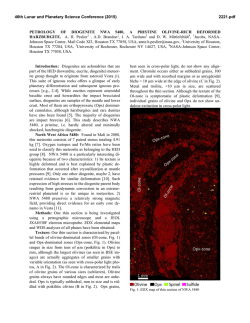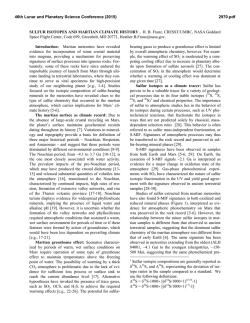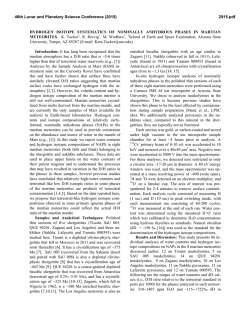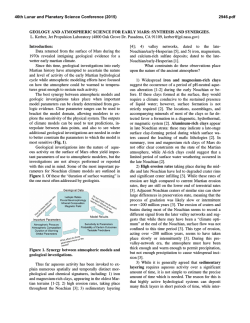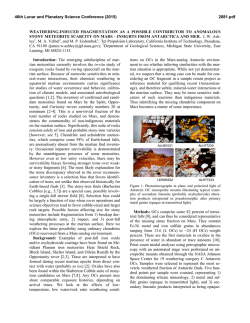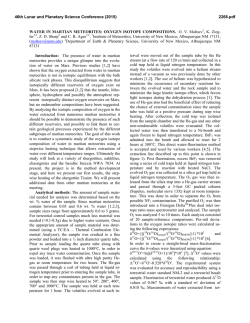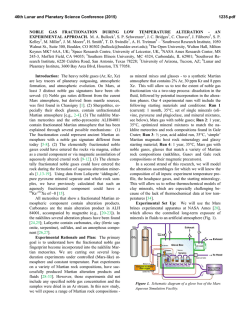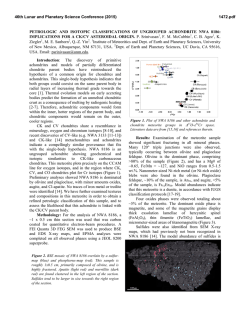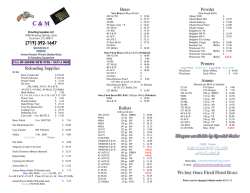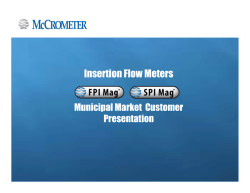
1483 - USRA
46th Lunar and Planetary Science Conference (2015) 1483.pdf The mineralogical record of fO2 variation and alteration in Northwest Africa 8159 (NWA 8159). Evidence for the interaction between a mantle derived martian basalt and a crustal component(s). Charles, K. Shearer1, Aaron S. Bell1, Paul V. Burger1, Francis M. McCubbin1, Carl Agee1, Justin Simon2 , and James J. Papike1. 1Institute of Meteoritics, Department of Earth and Planetary Science, University of New Mexico, Albuquerque, New Mexico 87131, 2 NASA Johnson Space Center, Houston, TX 77058. Introduction: A prominent geochemical feature of basaltic magmatism on Mars is the large range in initial Sr isotopic ratios (0.702 – 0.724) and initial Nd values ( -10 to +50). Within this range, the shergottites fall into three distinct sub-groups. Each sub-group has distinct bulk rock REE patterns, mineral trace element signatures, oxygen fugacity of crystallization, and stable isotope signatures. In contrast, nakhlites and chassignites have depleted Nd values (≥+15), have REE patterns that are light REE enriched, and appear to have crystallized near the FMQ buffer (e.g. [5] and references within). The characteristics of these various martian basalts have been linked to different reservoirs in the martian crust and mantle, and their interactions during the petrogenesis of these magmas [e.g. 1-5]. These observations pose interesting interpretive challenges to our understanding of the conditions of the martian mantle (e.g. fO2) and the interaction of mantlederived magmas with the martian crust and the nearsurface environment. Martian meteorite NWA 8159 is a unique finegrained augite basalt derived from a highly depleted mantle source as reflected in its initial Nd value, contains a pronounced light REE depleted pattern, and crystallized presumably under very oxidizing conditions [6,7]. Although considerably older than both shergottites and nakhlites, it has been petrogenetically linked to both styles of martian magmatism [6,7]. These unique characteristics of NWA 8159 may provide an additional perspective for deciphering the petrogenesis of martian basalts and the nature of the martian crust. Analytical Approach: Thin sections of NWA 8159 were initially examined and documented using backscattered electron imaging (BSE) on the JEOL JXA-8200 Superprobe electron microprobe (EMP) in the Institute of Meteoritics. Wave-length dispersive X-ray maps were collected for Cr, Ca, Mn, P and Ti, while energy dispersive (EDS) maps were collected for Mg and Fe. These maps were collected using a 15 kV accelerating voltage, a 500 nA beam current and a dwell time of 800 ms/pixel. Quantitative point analyses were conducted of various silicates and oxide phases using the EMP. These analyses employed an accelerating voltage of 15 kV, a beam current of 20 nA, and a spot size from 1-3 µm. An FEI Quanta 3D Field Emission Gun FIB/SEM/EDS was used to image sample texture and chemistry at the nanoscale, focus on a specific nano- scale region, and cut and thin micro-scale wide, nano-scale thick section for transmission electron microscope (TEM) analysis. The locations of the FIB cuts were primarily within cores and rims of olivine (OL). A JEOL 2010 TEM with Oxford INCA system ultrathin window energy dispersive spectroscopy detector for nanoscale chemical analysis of light to heavy elements was used for sample mapping of chemistry and selected area diffraction for phase analysis. A JEOL 2010F FASTEM field emission gun capable of scanning transmission electron microscopy (STEM/TEM) with point to point resolution of 0.194 nm and minimum probe size of 0.14 nm was used for diffraction contrast and energy filtered TEM imaging. Chromium K-edge XANES data were acquired with the X-ray microprobe of GSECARS beamline 13-ID-E at the Advanced Photon Source (APS), Argonne National Laboratory, Illinois. The X-ray source at APS beamline 13-ID-E was a 72-pole, 33 mm period undulator. The beam was focused to a final spot size of 5μm by 5μm with dynamically configured Kirkpatrick-Baez focusing mirrors. All spectra were acquired in fluorescence. Spectra were acquired in three distinct crystallographic orientations and merged in order to mitigate the effects of crystalline anisotropy on the intensity of the peak associated with the 1s-4s transition [8,9]. Results: BSE images of OL (50-200µm) and adjacent phases illustrate OL cores exhibit alteration and that adjacent orthopyroxene (OPX) spatially associated with OL rims are inter-grown with magnetite (MAG) (Fig. 1). Similar textures have been identified in nakhlites [5] and terrestrial basalts and gabbros [e.g. 10-13]. X-ray maps (Fig. 1) and point analyses illustrate that the “OL” cores have different Mg# (Mg/(Mg+Fe)) than rims and that they are enriched in P (up to 1.4 wt%) and Al2O3. TEM imaging and analyses of the “OL” cores indicates that it is an intergrowth of OL plus multiple nonmagmatic phases. The alteration appears to be unrelated to terrestrial carbonate that occurs in veins that cross-cut martian silicates. The valence state of Cr (Cr2+,Cr3+) in unaltered and modified OL indicate all Cr is trivalent. Ni concentration in the OL is less than 200 ppm. The OPX associated with the OL rims has a very low Wo content (Wo2-1) and exhibits zoning in Mg# from 0.29-0.60. The OPX with the higher Mg# are generally intergrown with the MAG. The MAG in the intergrowths is essentially end- 46th Lunar and Planetary Science Conference (2015) member MAG with very small amounts of TiO2 or Cr2O3. Based on pyroxene stoichiometry, the Fe3+/(Fe3++Fe2+) of the OPX is less than 2%. The Fe3+/(Fe3++Fe2+) in the clinopyroxene (Wo40En35Fs25 to Wo22En18Fs60) is only slightly higher and more variable (>3%). Discussion: Several interesting observations may provide insight into the petrogenesis of NWA 8159. The MAG-OPX intergrowths such as those associated with the small OL grains in NWA 8159 have been attributed to both magmatic [e.g. 5,10,12] and very late-stage magmatic to subsolidus [e.g. 12,13] processes and are produced at particular fO2 conditions. Presnall [12] demonstrated that the magmatic processes producing this texture reflect a reaction occurring at the OL-OPX-spinel peritectic (OL + peritectic liquid ↔ spinel + OPX) in the MgOiron oxide-SiO2 system (1326C at FMQ+1). An interesting point from the experiments of [12] is that only at fO2 conditions several log units above FMQ does the Fe-Ti spinel composition even approach end-member MAG compositions. Most recently, results from [14,15] were interpreted as indicating that for Fe-rich martian magmas end-member MAG was produced either at conditions much more oxidizing than FMQ or at subsolidus conditions. Morse [13] suggested that the “oxysymplectites” of MAG + OPX were produced by the interaction of OL with either a late-stage Fe-rich residual liquid with excess oxygen or an oxygen-rich vapor phase released near the end of crystallization. Yoder and Tilley [12] provided examples of potential subsolidus 1483.pdf reactions. One potential reaction relevant to NWA 8159 is 3 OL + 1/2O2 ↔ 3 OPX + MAG [5,12]. We have modeled fO2 of this reaction as a function of temperature using mineral compositions from NWA 8159. Our modeling suggests that this reaction occurs at fO2 conditions ranging from FMQ-1.9 (at 700C) to FMQ-1 (at 1000C). These calculations indicate that end-member MAG can be produced at somewhat more reducing conditions than would be expected for a magmatic origin. Somewhat troubling for a subsolidus origin for the MAG+OPX intergrowths is that their morphology is not similar to other “wormy” intergrowths of OPX ± trolite ± Fe-metal ± oxide after OL produced at subsolidus conditions [e.g. 16,17]. Based on Y98 experiments of Bell et al. [8], the measured valance state for Cr is consistent with early OL crystallizing at an fO2 more oxidizing than FMQ or a subsolidus oxidation of the Cr in OL. Subsolidus alteration is reflected in the preferential modification of the P-rich cores of the OL. This correlation may imply that the P-enrichment in the OL cores is magmatic and that the alteration is martian in origin. Other martian basalts have OL that exhibit substantial P zoning, although P concentrations in NWA 8159 are considerably higher [4]. The link between this alteration and the OPX + MAG intergrowths is unknown. Further examination of the alteration mineralogy of the OL cores continues using TEM. In summary, NWA 8159 appears to have many geochemical and mineralogical characteristics that are generally similar to nakhlites. These characteristics reflect some near-solidus to subsolidus processes. These include oxidation of OL and preferential alteration of phosphorous-rich cores of OL. These processes may reflect the addition of a crustal signature to the nakhlites which is also reflected in the Cl-isotopic characteristics of these lithologies [18]. There still are distinctive differences, however, such as its initial Nd value (+45) [7] that suggest NWA 8159 may have some affinity to the petrogenesis of both recognized styles of martian magmatism or involves an entirely distinct mantle source. References: [1] Herd et al. (2002) GCA 66, 2025-2036. [2] Wadhwa (2001) Science 291, 1527-1530. [3] Synes et al. (2008) GCA 72, 1696-1710. [4] Shearer et al. (2013) GCA 120, 17-38 [5] Treiman and Irving (2008) MAPS 43, 829-854. [6] Agee et al. (2014) 77th Met Soc meeting. Abst. #5397. [7] Simon et al. (2014) 77th Met Soc meeting Abst. #5363. [8] Bell et al. (2014) Am. Min. 99, 1404-1412. [9] Berry et al. (2006) Am. Min. 91, 1901-1908 [10] Kuno (1950) GSA Bull. 61, 957-1020. [11] Presnall (1966) AJS 264, 753-809. [12] Yoder and Tilley (1962) Jour. Pet. 3, 342532. [13] Morse (1969) GSA Mem. 112. [14] Righter et al. (2013) Am. Min. 98, 616-628. [15] Papike et al. (2015) Am. Min. 100, in press. [16] Shearer et al (2012) GCA 83, 138-158. [17] Bell et al. (2015) 46th LPSC (this meeting). [18] Shearer et al. (2014) workshop on volatiles in the martian interior. Abst. # 1021.
© Copyright 2024

